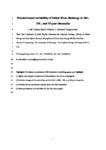Wavelet-based variability of Yellow River discharge at 500-, 100-, and 50-year timescales
| dc.contributor.author | Su, L | |
| dc.contributor.author | Miao, Chiyuan | |
| dc.contributor.author | Borthwick, Alistair | |
| dc.contributor.author | Duan, Q | |
| dc.date.accessioned | 2021-08-22T16:45:40Z | |
| dc.date.available | 2021-08-22T16:45:40Z | |
| dc.date.issued | 2017-09 | |
| dc.identifier.issn | 1342-937X | |
| dc.identifier.uri | http://hdl.handle.net/10026.1/17705 | |
| dc.description.abstract |
Water scarcity in the Yellow River, China, has become increasingly severe over the past half century. In this paper, wavelet transform analysis was used to detect the variability of natural, observed, and reconstructed streamflow in the Yellow River at 500-, 100-, and 50-year timescales. The periodicity of the streamflow series and the co-varying relationships between streamflow and atmospheric circulation indices/sunspot number were assessed by means of continuous wavelet transform (CWT) and wavelet transform coherence (WTC) analyses. The CWT results showed intermittent oscillations in streamflow with increasing periodicities of 1–6 years at all timescales. Significant multidecadal and century-scale periodicities were identified in the 500-year streamflow series. The WTC results showed intermittent interannual covariance of streamflow with atmospheric circulation indices and sunspots. At the 50-year timescale, there were significant decadal oscillations between streamflow and the Arctic Oscillation (AO) and the Pacific Decadal Oscillation (PDO), and bidecadal oscillations with the PDO. At the 100-year timescale, there were significant decadal oscillations between streamflow and Niño 3.4, the AO, and sunspots. At the 500-year timescale, streamflow in the middle reaches of the Yellow River showed prominent covariance with the AO with an approximately 32-year periodicity, and with sunspots with an approximately 80-year periodicity. Atmospheric circulation indices modulate streamflow by affecting temperature and precipitation. Sunspots impact streamflow variability by influencing atmospheric circulation, resulting in abundant precipitation. In general, for both the CWT and the WTC results, the periodicities were spatially continuous, with a few gradual changes from upstream to downstream resulting from the varied topography and runoff. At the temporal scale, the periodicities were generally continuous over short timescales and discontinuous over longer timescales. | |
| dc.format.extent | 94-105 | |
| dc.language | en | |
| dc.language.iso | en | |
| dc.publisher | Elsevier BV | |
| dc.title | Wavelet-based variability of Yellow River discharge at 500-, 100-, and 50-year timescales | |
| dc.type | journal-article | |
| dc.type | Journal Article | |
| plymouth.volume | 49 | |
| plymouth.publication-status | Published | |
| plymouth.journal | Gondwana Research | |
| dc.identifier.doi | 10.1016/j.gr.2017.05.013 | |
| plymouth.organisational-group | /Plymouth | |
| plymouth.organisational-group | /Plymouth/Faculty of Science and Engineering | |
| plymouth.organisational-group | /Plymouth/Faculty of Science and Engineering/School of Engineering, Computing and Mathematics | |
| plymouth.organisational-group | /Plymouth/Users by role | |
| plymouth.organisational-group | /Plymouth/Users by role/Academics | |
| dc.rights.embargoperiod | Not known | |
| rioxxterms.versionofrecord | 10.1016/j.gr.2017.05.013 | |
| rioxxterms.licenseref.uri | http://www.rioxx.net/licenses/all-rights-reserved | |
| rioxxterms.type | Journal Article/Review |


